Page 286 of 347

Disposing Of Used Engine Oil And Oil Filters
Care should be taken in disposing of used engine oil and
oil filters from your vehicle. Used oil and oil filters,
indiscriminately discarded, can present a problem to the
environment. Contact your authorized dealer, service
station or governmental agency for advice on how and
where used oil and oil filters can be safely discarded in
your area.
Engine Air Cleaner Filter
CAUTION!
All air entering the engine intake must be filtered.
The abrasive particles in unfiltered air will cause
rapid wear to engine components.
WARNING!
The air induction system (air cleaner, hoses, etc.)
provides a measure of protection. Do not remove the
air induction system (air cleaner, hoses, etc.) unless
such removal is necessary for repair or maintenance.
Make sure that no one is near the engine compart-
ment before starting the vehicle with the air induc-
tion system (air cleaner, hoses, etc.) removed. Failure
to do so can result in serious personal injury.
The condition of the air cleaner filter is monitored by the
Engine Control Module. The “SERVICE AIR FILTER”
message will display in the Electronic Vehicle Informa-
tion Center (EVIC) or Driver Information Display (DID)
when service is required. Refer to “Electronic Vehicle
Information Center (EVIC)” or “Driver Information Dis-
play (DID)” in “Understanding Your Instrument Panel”
for further information.
284 MAINTAINING YOUR VEHICLE
Page 287 of 347
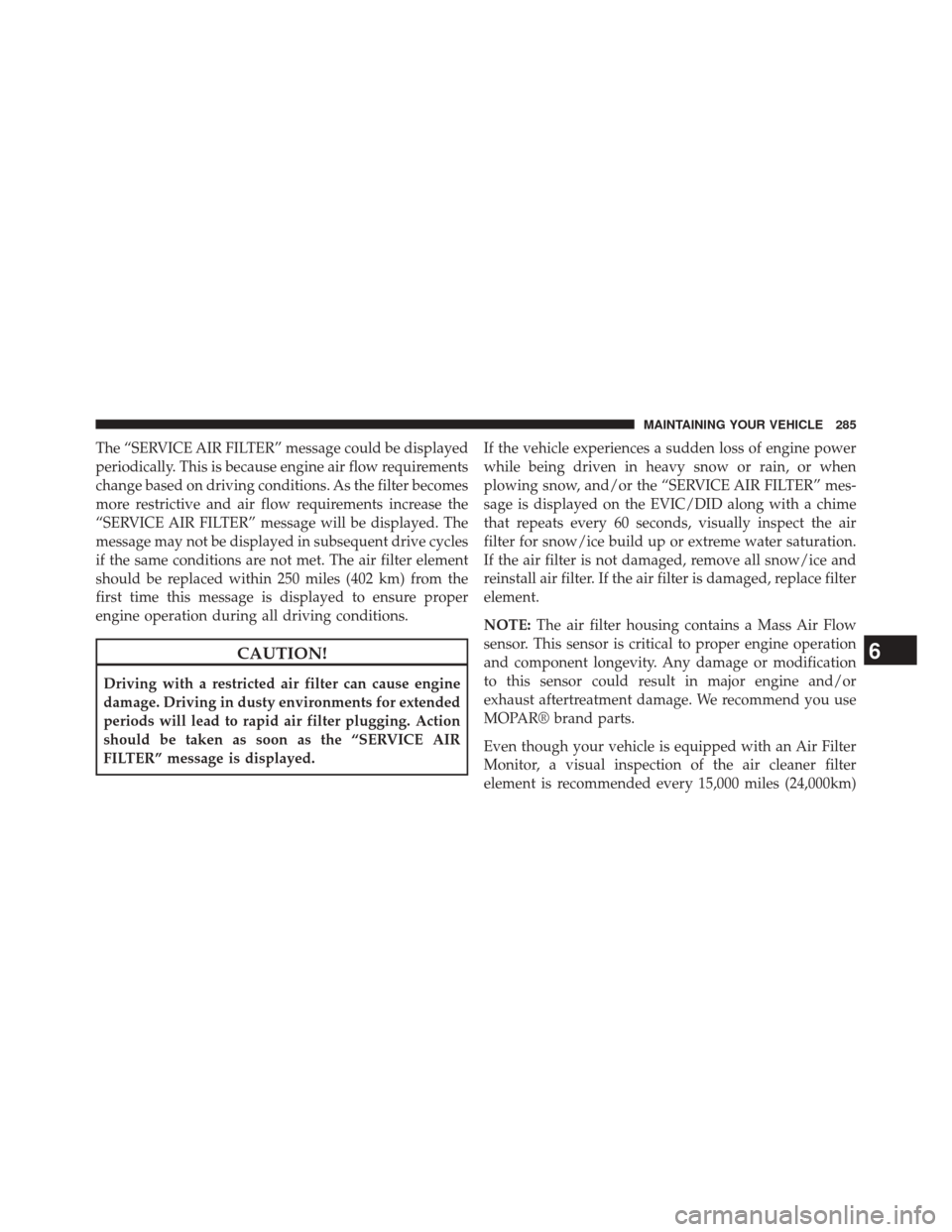
The “SERVICE AIR FILTER” message could be displayed
periodically. This is because engine air flow requirements
change based on driving conditions. As the filter becomes
more restrictive and air flow requirements increase the
“SERVICE AIR FILTER” message will be displayed. The
message may not be displayed in subsequent drive cycles
if the same conditions are not met. The air filter element
should be replaced within 250 miles (402 km) from the
first time this message is displayed to ensure proper
engine operation during all driving conditions.
CAUTION!
Driving with a restricted air filter can cause engine
damage. Driving in dusty environments for extended
periods will lead to rapid air filter plugging. Action
should be taken as soon as the “SERVICE AIR
FILTER” message is displayed.If the vehicle experiences a sudden loss of engine power
while being driven in heavy snow or rain, or when
plowing snow, and/or the “SERVICE AIR FILTER” mes-
sage is displayed on the EVIC/DID along with a chime
that repeats every 60 seconds, visually inspect the air
filter for snow/ice build up or extreme water saturation.
If the air filter is not damaged, remove all snow/ice and
reinstall air filter. If the air filter is damaged, replace filter
element.
NOTE:
The air filter housing contains a Mass Air Flow
sensor. This sensor is critical to proper engine operation
and component longevity. Any damage or modification
to this sensor could result in major engine and/or
exhaust aftertreatment damage. We recommend you use
MOPAR® brand parts.
Even though your vehicle is equipped with an Air Filter
Monitor, a visual inspection of the air cleaner filter
element is recommended every 15,000 miles (24,000km)
6
MAINTAINING YOUR VEHICLE 285
Page 288 of 347
or 12 months – whichever occurs first.Under no circum-
stances should the air cleaner filter element exceed
30,000 miles (48,000 km) or 24 months, whichever comes
first.
CAUTION!
Many aftermarket performance air filter elements do
not adequately filter the air entering the engine. Use
of such filters can severely damage your engine.
Engine Air Cleaner Filter Inspection and
Replacement
Inspect engine air cleaner filter for dirt and or debris, if
you find evidence of either dirt or debris you should
change your air cleaner filter.
Engine Air Cleaner Filter Removal
1. Remove the screws from the air cleaner cover.
Air Cleaner Filter Cover
1 — Clean Air Hose Clamp
2 — Air Cleaner Filter Cover
3 — Screws
286 MAINTAINING YOUR VEHICLE
Page 289 of 347
2. Lift the air cleaner cover to access the air cleaner filter. 3. Remove the air cleaner filter element from the housingassembly.
Open Air Cleaner Filter Assembly
1 — Air Cleaner Cover
2 — Air Cleaner Filter
Air Cleaner Filter
1 — Air Cleaner Filter
2 — Air Cleaner Filter Inspection Surface
6
MAINTAINING YOUR VEHICLE 287
Page 290 of 347
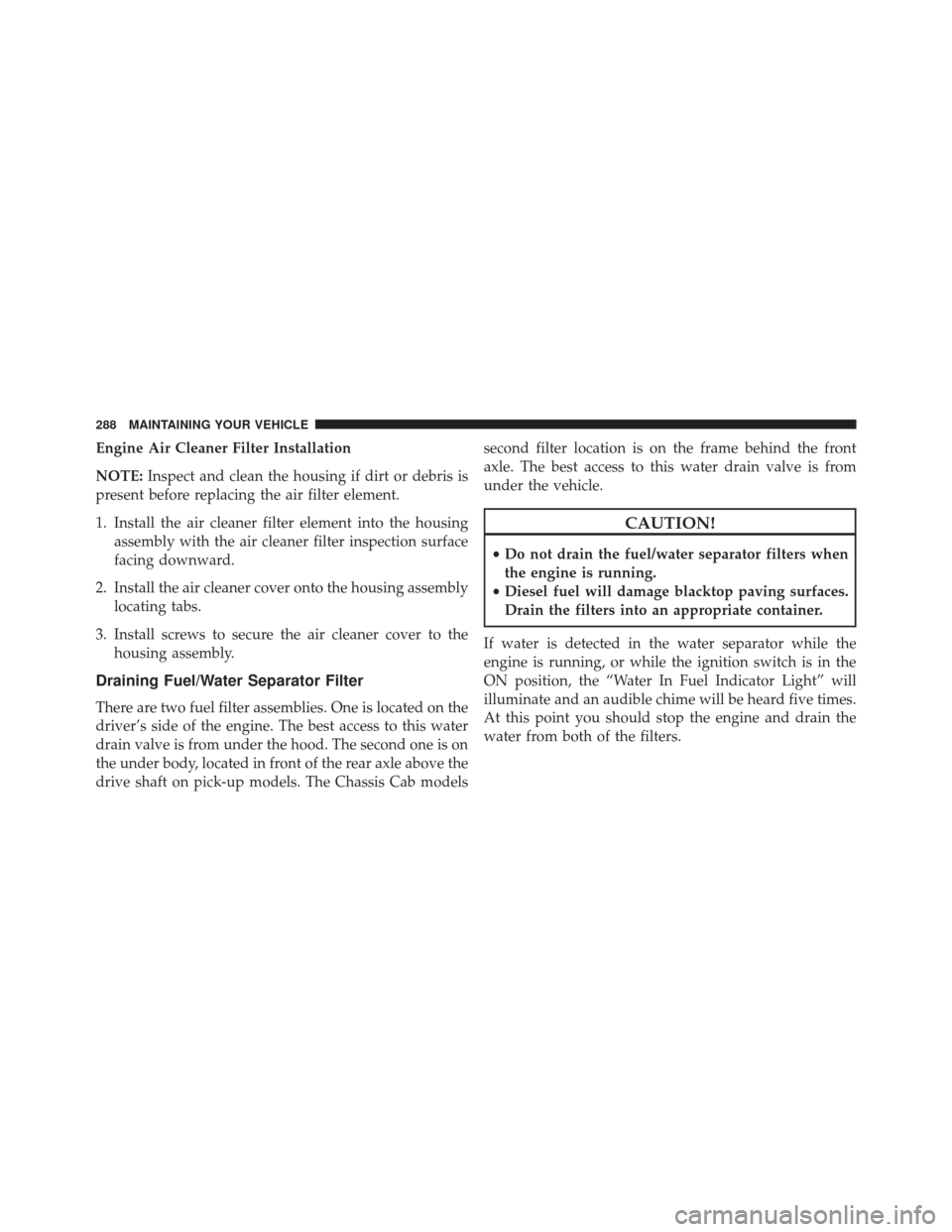
Engine Air Cleaner Filter Installation
NOTE:Inspect and clean the housing if dirt or debris is
present before replacing the air filter element.
1. Install the air cleaner filter element into the housing assembly with the air cleaner filter inspection surface
facing downward.
2. Install the air cleaner cover onto the housing assembly locating tabs.
3. Install screws to secure the air cleaner cover to the housing assembly.
Draining Fuel/Water Separator Filter
There are two fuel filter assemblies. One is located on the
driver’s side of the engine. The best access to this water
drain valve is from under the hood. The second one is on
the under body, located in front of the rear axle above the
drive shaft on pick-up models. The Chassis Cab models second filter location is on the frame behind the front
axle. The best access to this water drain valve is from
under the vehicle.
CAUTION!
•
Do not drain the fuel/water separator filters when
the engine is running.
• Diesel fuel will damage blacktop paving surfaces.
Drain the filters into an appropriate container.
If water is detected in the water separator while the
engine is running, or while the ignition switch is in the
ON position, the “Water In Fuel Indicator Light” will
illuminate and an audible chime will be heard five times.
At this point you should stop the engine and drain the
water from both of the filters.
288 MAINTAINING YOUR VEHICLE
Page 309 of 347
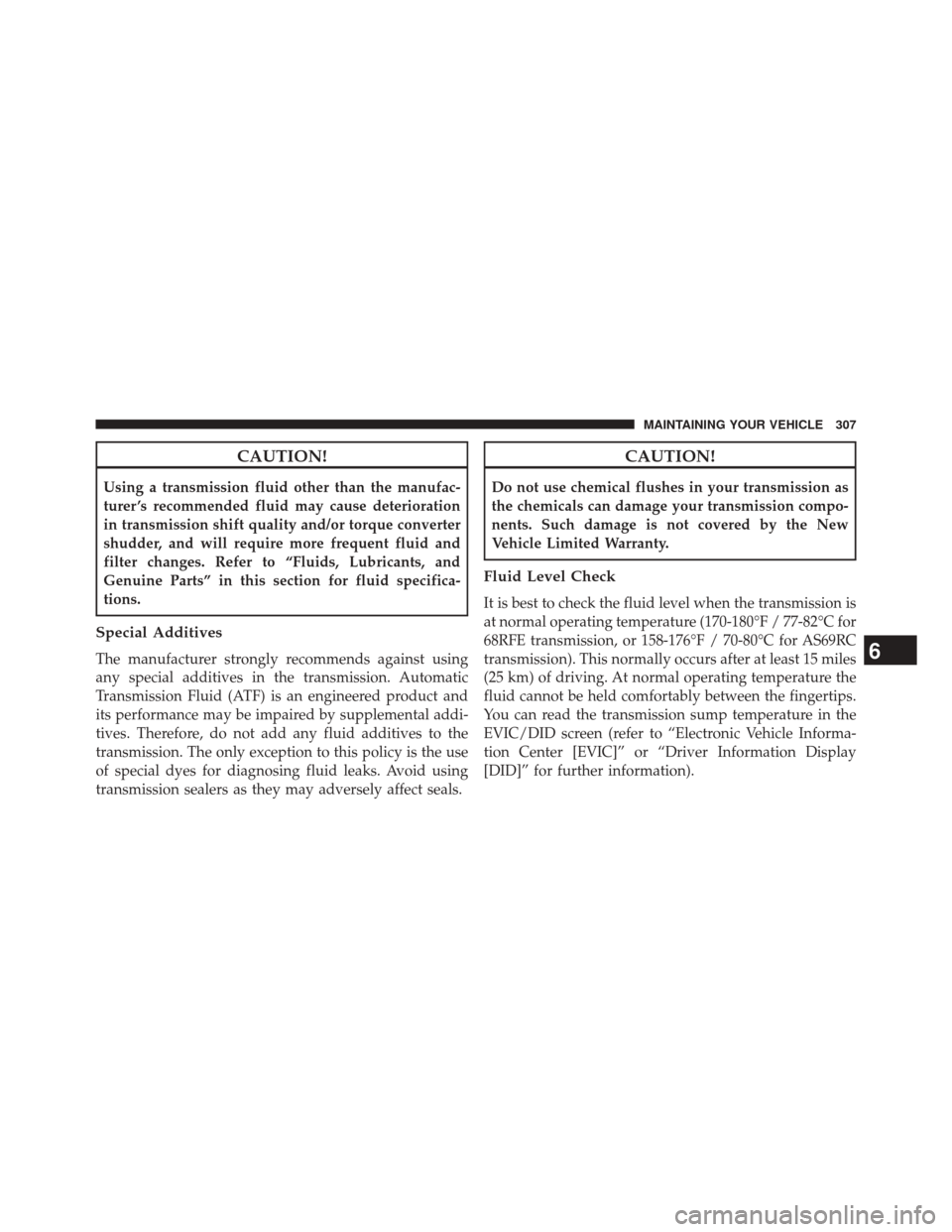
CAUTION!
Using a transmission fluid other than the manufac-
turer ’s recommended fluid may cause deterioration
in transmission shift quality and/or torque converter
shudder, and will require more frequent fluid and
filter changes. Refer to “Fluids, Lubricants, and
Genuine Parts” in this section for fluid specifica-
tions.
Special Additives
The manufacturer strongly recommends against using
any special additives in the transmission. Automatic
Transmission Fluid (ATF) is an engineered product and
its performance may be impaired by supplemental addi-
tives. Therefore, do not add any fluid additives to the
transmission. The only exception to this policy is the use
of special dyes for diagnosing fluid leaks. Avoid using
transmission sealers as they may adversely affect seals.
CAUTION!
Do not use chemical flushes in your transmission as
the chemicals can damage your transmission compo-
nents. Such damage is not covered by the New
Vehicle Limited Warranty.
Fluid Level Check
It is best to check the fluid level when the transmission is
at normal operating temperature (170-180°F / 77-82°C for
68RFE transmission, or 158-176°F / 70-80°C for AS69RC
transmission). This normally occurs after at least 15 miles
(25 km) of driving. At normal operating temperature the
fluid cannot be held comfortably between the fingertips.
You can read the transmission sump temperature in the
EVIC/DID screen (refer to “Electronic Vehicle Informa-
tion Center [EVIC]” or “Driver Information Display
[DID]” for further information).
6
MAINTAINING YOUR VEHICLE 307
Page 313 of 347
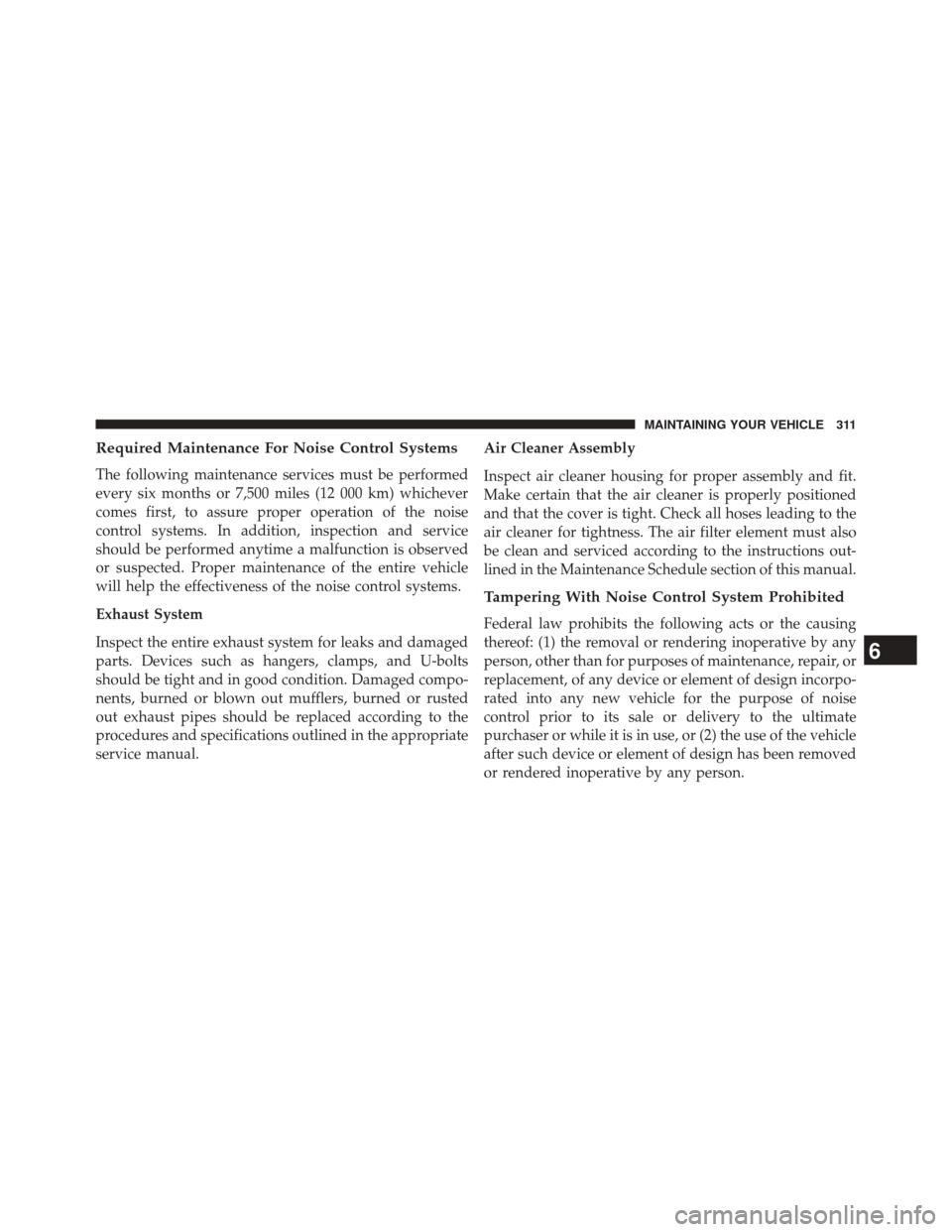
Required Maintenance For Noise Control Systems
The following maintenance services must be performed
every six months or 7,500 miles (12 000 km) whichever
comes first, to assure proper operation of the noise
control systems. In addition, inspection and service
should be performed anytime a malfunction is observed
or suspected. Proper maintenance of the entire vehicle
will help the effectiveness of the noise control systems.
Exhaust System
Inspect the entire exhaust system for leaks and damaged
parts. Devices such as hangers, clamps, and U-bolts
should be tight and in good condition. Damaged compo-
nents, burned or blown out mufflers, burned or rusted
out exhaust pipes should be replaced according to the
procedures and specifications outlined in the appropriate
service manual.Air Cleaner Assembly
Inspect air cleaner housing for proper assembly and fit.
Make certain that the air cleaner is properly positioned
and that the cover is tight. Check all hoses leading to the
air cleaner for tightness. The air filter element must also
be clean and serviced according to the instructions out-
lined in the Maintenance Schedule section of this manual.
Tampering With Noise Control System Prohibited
Federal law prohibits the following acts or the causing
thereof: (1) the removal or rendering inoperative by any
person, other than for purposes of maintenance, repair, or
replacement, of any device or element of design incorpo-
rated into any new vehicle for the purpose of noise
control prior to its sale or delivery to the ultimate
purchaser or while it is in use, or (2) the use of the vehicle
after such device or element of design has been removed
or rendered inoperative by any person.
6
MAINTAINING YOUR VEHICLE 311
Page 314 of 347
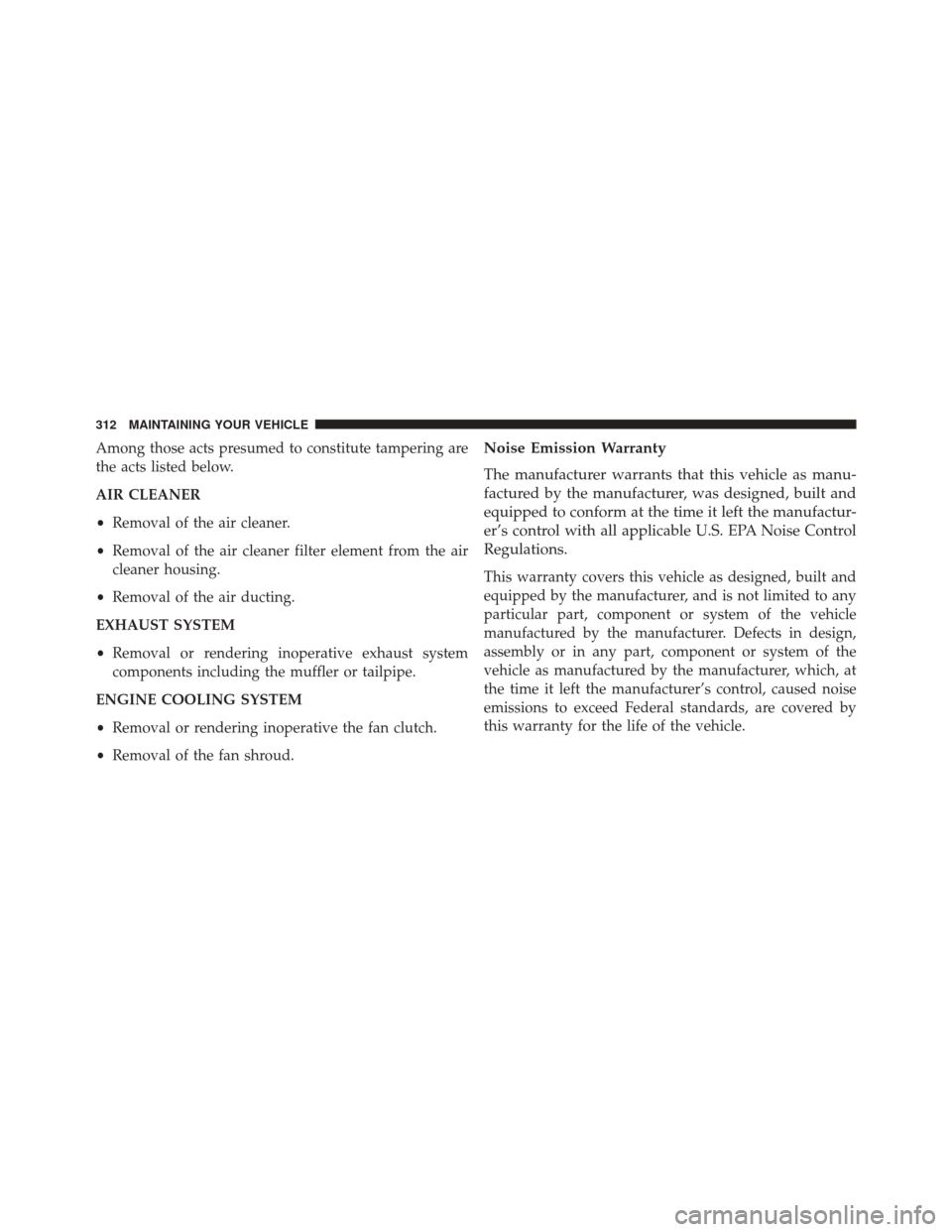
Among those acts presumed to constitute tampering are
the acts listed below.
AIR CLEANER
•Removal of the air cleaner.
• Removal of the air cleaner filter element from the air
cleaner housing.
• Removal of the air ducting.
EXHAUST SYSTEM
• Removal or rendering inoperative exhaust system
components including the muffler or tailpipe.
ENGINE COOLING SYSTEM
• Removal or rendering inoperative the fan clutch.
• Removal of the fan shroud.Noise Emission Warranty
The manufacturer warrants that this vehicle as manu-
factured by the manufacturer, was designed, built and
equipped to conform at the time it left the manufactur-
er’s control with all applicable U.S. EPA Noise Control
Regulations.
This warranty covers this vehicle as designed, built and
equipped by the manufacturer, and is not limited to any
particular part, component or system of the vehicle
manufactured by the manufacturer. Defects in design,
assembly or in any part, component or system of the
vehicle as manufactured by the manufacturer, which, at
the time it left the manufacturer’s control, caused noise
emissions to exceed Federal standards, are covered by
this warranty for the life of the vehicle.
312 MAINTAINING YOUR VEHICLE